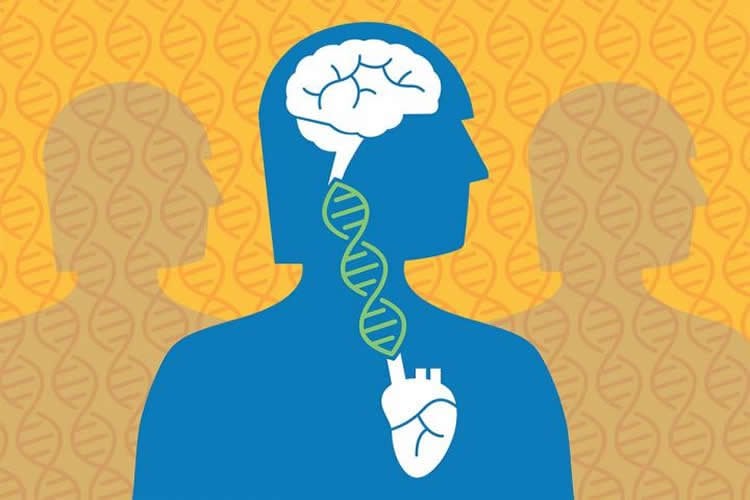Summary: Researchers have identified specific points on chromosome 11 that increase the risks of developing both cardiovascular disease and Alzheimer’s. The study reports managing cholesterol and triglyceride levels could help to reduce Alzheimer’s risk.
Source: WUSTL.
Studying DNA from more than 1.5 million people, an international team of researchers — led by Washington University School of Medicine in St. Louis and the University of California, San Francisco — has identified points of DNA that increase the risk of cardiovascular disease and also heighten the risk for Alzheimer’s disease.
Scientists have long been aware of connections between variations of the APOE gene, which is involved in cholesterol and lipid metabolism, and Alzheimer’s disease. That gene is known to double the risk for Alzheimer’s disease in some patients and increase risk by up to 12 times in others. But in the new study, the researchers identified other DNA points that also appear to be involved both in cardiovascular disease risk and the risk for Alzheimer’s.
The findings are published Nov. 12 in the journal Acta Neuropathologica.
“These findings represent an opportunity to consider repurposing drugs that target pathways involved in lipid metabolism,” said Celeste M. Karch, PhD, an assistant professor of psychiatry at Washington University School of Medicine. “Armed with these findings, we can begin to think about whether some of those drugs might be useful in preventing or delaying Alzheimer’s disease “Our study emphasizes that there’s much to learn about how genes driving Alzheimer’s disease risk also increase the risk for other health problems, particularly cardiovascular disease, and vice versa. So we really need to think about these risks more holistically.”
The study is the largest genetic study of Alzheimer’s disease. Karch is one of its co-senior authors, along with Rahul S. Desikan, MD, PhD, an assistant professor of neuroradiology at UC San Francisco. The study’s first author is Iris Broce-Diaz, PhD, a postdoctoral researcher in Desikan’s lab.
They looked at differences in the DNA of people with factors that contribute to heart disease or Alzheimer’s disease and identified 90 points across the genome that were associated with risk for both diseases. Their analysis confirmed that six of the 90 regions had very strong effects on Alzheimer’s and heightened blood lipid levels, including several within genes that had not previously been linked to dementia risk. These included several points within the CELF1/MTCH2/SPI1 region on chromosome 11 that previously had been linked to the immune system.
The researchers confirmed their most promising findings in a large genetic study of healthy adults by showing that these same risk factors were more common in people with a family history of Alzheimer’s, even though they had not themselves developed dementia or other symptoms such as memory loss.

They focused on specific risk factors for heart disease — such as a high body mass index, type 2 diabetes and elevated triglyceride and cholesterol levels (HDL, LDL, and total cholesterol) — to see if any of these well-recognized risk factors for heart disease also were genetically related to Alzheimer’s risk.
“The genes that influenced lipid metabolism were the ones that also were related to Alzheimer’s disease risk,” Karch said. “Genes that contribute to other cardiovascular risk factors, like body mass index and type 2 diabetes, did not seem to contribute to genetic risk for Alzheimer’s.”
And Desikan said that although more research is needed, the new findings suggest that if the right genes and proteins could be targeted, it may be possible to lower the risk for Alzheimer’s disease in some people by managing their cholesterol and triglycerides.
“These results imply that irrespective of what causes what, cardiovascular and Alzheimer’s pathology co-occur because they are linked genetically. That is, if you carry this handful of gene variants, you may be at risk not only for heart disease but also for Alzheimer’s,” he said.
Broce I, Karch C, Desikan R, et al. Dissecting the genetic relationship between cardiovascular risk factors and Alzheimer’s disease. Acta Neuropathologica, published online Nov. 9, 2018.
Funding: This work was supported by the National Institute on Aging at the National Institutes of Health (NIH), grant numbers NIH-AG046374 and K01 AG049152. Additional funding from a National Alzheimer’s Coordinating Center Junior Investigator Award, a Radiological Society of North America Resident/Fellow Award, a Foundation American Society of Neuroradiology Alzheimer’s Imaging Grant, the Research Council of Norway, the South East Norway Health Authority, the Norwegian Health Association and the KG Jebsen Foundation.
Source: Jim Dryden – WUSTL
Publisher: Organized by NeuroscienceNews.com.
Image Source: NeuroscienceNews.com image is credited to Michael Worful.
Original Research: Abstract for “Dissecting the genetic relationship between cardiovascular risk factors and Alzheimer’s disease” by Iris J. Broce, Chin Hong Tan, Chun Chieh Fan, Iris Jansen, Jeanne E. Savage, Aree Witoelar, Natalie Wen, Christopher P. Hess, William P. Dillon, Christine M. Glastonbury, Maria Glymour, Jennifer S. Yokoyama, Fanny M. Elahi, Gil D. Rabinovici, Bruce L. Miller, Elizabeth C. Mormino, Reisa A. Sperling, David A. Bennett, Linda K. McEvoy, James B. Brewer, Howard H. Feldman, Bradley T. Hyman, Margaret Pericak-Vance, Jonathan L. Haines, Lindsay A. Farrer, Richard Mayeux, Gerard D. Schellenberg, Kristine Yaffe, Leo P. Sugrue, Anders M. Dale, Danielle Posthuma, Ole A. Andreassen, Celeste M. Karch, and Rahul S. Desikan in Acta Neuropathologica. Published November 9 2018.
doi:10.1007/s00401-018-1928-6
[cbtabs][cbtab title=”MLA”]WUSTL”Alzheimer’s Genetically Linked to Cardiovascular Disease.” NeuroscienceNews. NeuroscienceNews, 12 November 2018.
<https://neurosciencenews.com/alzheimers-genetics-cardiovascular-disease-10177/>.[/cbtab][cbtab title=”APA”]WUSTL(2018, November 12). Alzheimer’s Genetically Linked to Cardiovascular Disease. NeuroscienceNews. Retrieved November 12, 2018 from https://neurosciencenews.com/alzheimers-genetics-cardiovascular-disease-10177/[/cbtab][cbtab title=”Chicago”]WUSTL”Alzheimer’s Genetically Linked to Cardiovascular Disease.” https://neurosciencenews.com/alzheimers-genetics-cardiovascular-disease-10177/ (accessed November 12, 2018).[/cbtab][/cbtabs]
Abstract
Dissecting the genetic relationship between cardiovascular risk factors and Alzheimer’s disease
Cardiovascular (CV)- and lifestyle-associated risk factors (RFs) are increasingly recognized as important for Alzheimer’s disease (AD) pathogenesis. Beyond the ε4 allele of apolipoprotein E (APOE), comparatively little is known about whether CV-associated genes also increase risk for AD. Using large genome-wide association studies and validated tools to quantify genetic overlap, we systematically identified single nucleotide polymorphisms (SNPs) jointly associated with AD and one or more CV-associated RFs, namely body mass index (BMI), type 2 diabetes (T2D), coronary artery disease (CAD), waist hip ratio (WHR), total cholesterol (TC), triglycerides (TG), low-density (LDL) and high-density lipoprotein (HDL). In fold enrichment plots, we observed robust genetic enrichment in AD as a function of plasma lipids (TG, TC, LDL, and HDL); we found minimal AD genetic enrichment conditional on BMI, T2D, CAD, and WHR. Beyond APOE, at conjunction FDR < 0.05 we identified 90 SNPs on 19 different chromosomes that were jointly associated with AD and CV-associated outcomes. In meta-analyses across three independent cohorts, we found four novel loci within MBLAC1 (chromosome 7, meta-p = 1.44 × 10−9), MINK1 (chromosome 17, meta-p = 1.98 × 10−7) and two chromosome 11 SNPs within the MTCH2/SPI1 region (closest gene = DDB2, meta-p = 7.01 × 10−7 and closest gene = MYBPC3, meta-p = 5.62 × 10−8). In a large ‘AD-by-proxy’ cohort from the UK Biobank, we replicated three of the four novel AD/CV pleiotropic SNPs, namely variants within MINK1, MBLAC1, and DDB2. Expression of MBLAC1, SPI1, MINK1 and DDB2 was differentially altered within postmortem AD brains. Beyond APOE, we show that the polygenic component of AD is enriched for lipid-associated RFs. We pinpoint a subset of cardiovascular-associated genes that strongly increase the risk for AD. Our collective findings support a disease model in which cardiovascular biology is integral to the development of clinical AD in a subset of individuals.






